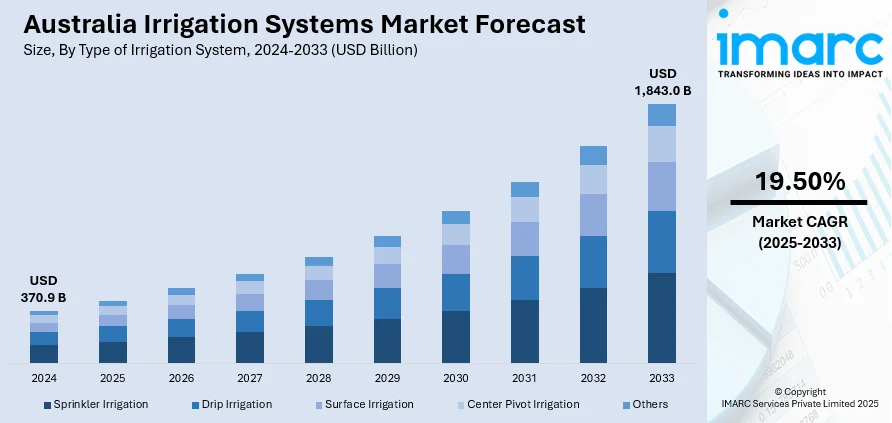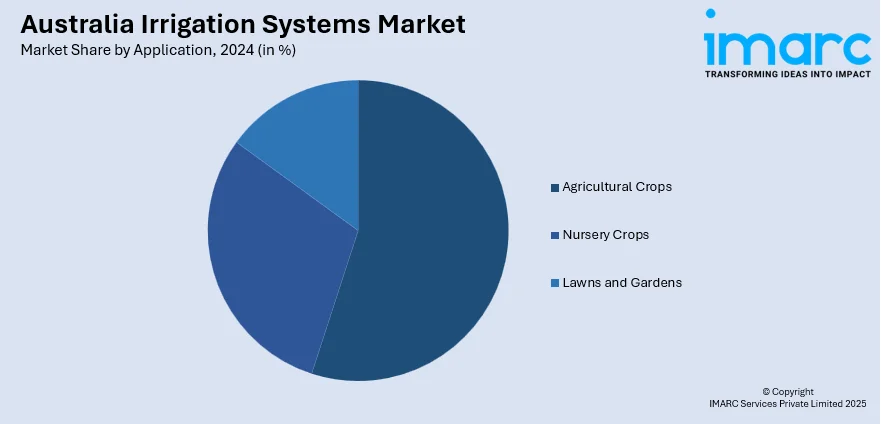
Australia Irrigation Systems Market Size, Share, Trends and Forecast by Type of Irrigation System, Crop Type, Application, and Region, 2025-2033
Australia Irrigation Systems Market Overview:
The Australia irrigation systems market size reached USD 370.9 Billion in 2024. Looking forward, IMARC Group expects the market to reach USD 1,843.0 Billion by 2033, exhibiting a growth rate (CAGR) of 19.50% during 2025-2033. The market is growing steadily, supported by rising demand for efficient water management and sustainable farming practices. Technological advancements, such as smart and automated systems, are enabling precise irrigation, improving crop productivity, and reducing water waste. Increased awareness about environmental benefits and supportive government policies are encouraging adoption across agricultural sectors. These positive trends are strengthening the competitive landscape and boosting the Australia irrigation systems market share.
|
Report Attribute
|
Key Statistics
|
|---|---|
|
Base Year
|
2024
|
|
Forecast Years
|
2025-2033
|
|
Historical Years
|
2019-2024
|
|
Market Size in 2024
|
USD 370.9 Billion |
|
Market Forecast in 2033
|
USD 1,843.0 Billion |
| Market Growth Rate 2025-2033 | 19.50% |
Australia Irrigation Systems Market Trends:
Technological Advancements in Irrigation Systems
Innovations in irrigation technology are significantly transforming the Australian agricultural sector. Modern systems now incorporate features like soil moisture sensors, weather forecasting tools, GPS integration, and remote monitoring, enabling precise control over water distribution. These smart technologies not only maximize irrigation schedules but also save water and energy. These solutions are being increasingly adopted by farmers in Australia to enhance efficiency, lower labor expenses, and increase crop yields. Availability of automated and data-driven systems is increasing the scalability and versatility of irrigation for variable sizes and types of farms. With the advancements in the availability and ease of use of these technologies, their uptake is gaining momentum. This technological advancement is key to fueling the growth and development of the Australia irrigation systems market for both small and large-scale agricultural activities.

To get more information on this market, Request Sample
Government Support and Subsidies
The Australian government actively supports the adoption of efficient irrigation systems through various programs, incentives, and funding initiatives. These initiatives seek to facilitate efficient water use and increase agricultural productivity. Farmers and agribusinesses are offered grants, rebates, and technical support to promote a switch from conventional irrigation to high-tech, water-saving technologies. Schemes at the national and state levels also seek to upgrade existing facilities, facilitate research and development, and enhance on-farm water management techniques. All such assistance lightens the economic load significantly, enabling modern systems to be more accessible. These efforts not only spur innovation but also support the overall aims of food security and environmental sustainability. Government backing is therefore a crucial driver in the widespread adoption of advanced irrigation systems throughout the Australian agricultural sector.
Rising Demand for High-Quality Agricultural Output
With the growing population and export opportunities, there is an increasing demand for consistent, high-quality agricultural produce in Australia. Efficient irrigation systems play a vital role in ensuring optimal crop health and yield by providing a timely and adequate water supply. Precision irrigation reduces the risks associated with under- or over-watering, helping farmers maintain better control over plant growth cycles. For high-value crops that are susceptible to changes in water, such fruits, vegetables, and nuts, this is especially crucial. The ability to improve crop uniformity and maximize land productivity gives farmers a competitive edge in both domestic and international markets. As agricultural businesses strive to meet quality standards and boost profitability, the demand for advanced irrigation systems continues to rise, contributing significantly to Australia irrigation systems market growth.
Australia Irrigation Systems Market Segmentation:
IMARC Group provides an analysis of the key trends in each segment of the market, along with forecasts at the country and regional levels for 2025-2033. Our report has categorized the market based on type of irrigation system, crop type, and application.
Type of Irrigation System Insights:
- Sprinkler Irrigation
- Drip Irrigation
- Surface Irrigation
- Center Pivot Irrigation
- Others
The report has provided a detailed breakup and analysis of the market based on the type of irrigation system. This includes sprinkler irrigation, drip irrigation, surface irrigation, center pivot irrigation, and others.
Crop Type Insights:
- Cereals and Grains
- Fruits and Vegetables
- Oilseeds and Pulses
- Cash Crops
A detailed breakup and analysis of the market based on the crop type have also been provided in the report. This includes cereals and grains, fruits and vegetables, oilseeds and pulses, and cash crops.
Application Insights:

- Agricultural Crops
- Nursery Crops
- Lawns and Gardens
A detailed breakup and analysis of the market based on the application have also been provided in the report. This includes agricultural crops, nursery crops, and lawns and gardens.
Regional Insights:
- Australia Capital Territory & New South Wales
- Victoria & Tasmania
- Queensland
- Northern Territory & Southern Australia
- Western Australia
The report has also provided a comprehensive analysis of all the major regional markets, which include the Australia Capital Territory & New South Wales, Victoria & Tasmania, Queensland, Northern Territory & Southern Australia, and Western Australia.
Competitive Landscape:
The market research report has also provided a comprehensive analysis of the competitive landscape. Competitive analysis such as market structure, key player positioning, top winning strategies, competitive dashboard, and company evaluation quadrant has been covered in the report. Also, detailed profiles of all major companies have been provided.
Australia Irrigation Systems Market News:
- In November 2024, CropX, a worldwide pioneer in digital agricultural solutions, introduced an innovative sensor across the Australasia region to monitor real-time plant water consumption in a field via evapotranspiration (ET). This innovative sensor, positioned above the canopy, links to the CropX agronomic farm management system, providing users with unparalleled insight into crop water usage and requirements, enabling data-informed irrigation planning and remote oversight that optimizes water efficiency.
- In October 2023, Murray Irrigation, Australia's biggest commercial provider of irrigation and environmental water, teamed with Charles Sturt University. In addition to advancing economic growth and industrial ties, collaboration will promote education, research, and business cooperation to address manpower shortages and environmental sustainability.
Australia Irrigation Systems Market Report Coverage:
| Report Features | Details |
|---|---|
| Base Year of the Analysis | 2024 |
| Historical Period | 2019-2024 |
| Forecast Period | 2025-2033 |
| Units | Billion USD |
| Scope of the Report |
Exploration of Historical Trends and Market Outlook, Industry Catalysts and Challenges, Segment-Wise Historical and Future Market Assessment:
|
| Type of Irrigation Systems Covered | Sprinkler Irrigation, Drip Irrigation, Surface Irrigation, Center Pivot Irrigation, Others |
| Crop Types Covered | Cereals and Grains, Fruits and Vegetables, Oilseeds and Pulses, Cash Crops |
| Applications Covered | Agricultural Crops, Nursery Crops, Lawns and Gardens |
| Regions Covered | Australia Capital Territory & New South Wales, Victoria & Tasmania, Queensland, Northern Territory & Southern Australia, Western Australia |
| Customization Scope | 10% Free Customization |
| Post-Sale Analyst Support | 10-12 Weeks |
| Delivery Format | PDF and Excel through Email (We can also provide the editable version of the report in PPT/Word format on special request) |
Key Questions Answered in This Report:
- How has the Australia irrigation systems market performed so far and how will it perform in the coming years?
- What is the breakup of the Australia irrigation systems market on the basis of the type of irrigation system?
- What is the breakup of the Australia irrigation systems market on the basis of crop type?
- What is the breakup of the Australia irrigation systems market on the basis of application?
- What is the breakup of the Australia irrigation systems market on the basis of region?
- What are the various stages in the value chain of the Australia irrigation systems market?
- What are the key driving factors and challenges in the Australia irrigation systems market?
- What is the structure of the Australia irrigation systems market and who are the key players?
- What is the degree of competition in the Australia irrigation systems market?
Key Benefits for Stakeholders:
- IMARC’s industry report offers a comprehensive quantitative analysis of various market segments, historical and current market trends, market forecasts, and dynamics of the Australia irrigation systems market from 2019-2033.
- The research report provides the latest information on the market drivers, challenges, and opportunities in the Australia irrigation systems market.
- Porter's five forces analysis assist stakeholders in assessing the impact of new entrants, competitive rivalry, supplier power, buyer power, and the threat of substitution. It helps stakeholders to analyze the level of competition within the Australia irrigation systems industry and its attractiveness.
- Competitive landscape allows stakeholders to understand their competitive environment and provides an insight into the current positions of key players in the market.
Need more help?
- Speak to our experienced analysts for insights on the current market scenarios.
- Include additional segments and countries to customize the report as per your requirement.
- Gain an unparalleled competitive advantage in your domain by understanding how to utilize the report and positively impacting your operations and revenue.
- For further assistance, please connect with our analysts.
 Request Customization
Request Customization
 Speak to an Analyst
Speak to an Analyst
 Request Brochure
Request Brochure
 Inquire Before Buying
Inquire Before Buying




.webp)




.webp)












